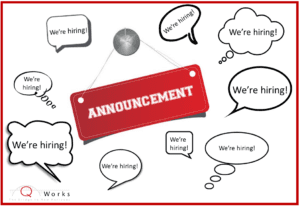2019 Market NOT Impacting Employment Boom
Michael Clegg | 02/04/2019

If you were watching the Stock Market in December to close out 2018, things appeared a bit shaky. Do NOT believe the hype. My 401k statement was not as pretty in 2018 as the year prior but all was not lost. There is a clear point that needs to be understood. The Stock Market is not the Economy. Naturally, there are some clear connections. Share prices rise and fall with Company profitability/performance. However, it is much more complex than that and a lot of speculation. Think back to the Stock Market crash of ’87. Stocks around the world fell 25%, yet the late 80’s the economy was performing well.
Many say that the Stock Market is forward looking at things yet to come. I prefer to look at employment numbers as a true indicator. Employment is the “tip of the spear” for companies. Labor is their greatest cost. Early 2000’s recession in March of 2001, unemployment was a moderate 6.3%. This was caused by the effects of the “Dot.com” bubble. It was brief and shallow.
I entered the Staffing Industry in the late 90’s and I do not remember 2001 being as bad for my business. The Great Recession, ’07-’09 officially lasted 18 months with unemployment raising to 10% in October of ’09. The cause was the collapse of the Housing Bubble due to the subprime mortgage crisis. The Dow did reach its lowest point in March 2009. While there was a natural hiring slow down following the announcement of the recession, my Teams experienced growth through the Great Recession. When my Team would ask questions about the recession my response was always, “We choose not to participate”. Professional employment tends to stay ahead of other sectors of employment in these downturns while labor intensive roles suffer.
Closing out 2018, The MRI Network of analysts published the following data: U.S. job growth experienced an unprecedented uptick in December while the Stock Market tumbled. The Bureau of Labor Statistics, (BLS) attributed the startling job growth observed in December to strong gains in the food and beverage, construction, healthcare, manufacturing and retail industries.
Healthcare boasted the biggest hiring increase, with organizations in the sector adding 50,000 jobs. This capped off a banner recruitment year in the healthcare industry, which managed to add 346,000 positions in 2018, a significant increase over the 284,000 roles it added in 2017. The manufacturing space added 32,000 positions in December, as firms specializing in durable goods, metal fabrication and electronics niches flourished. This pushed yearly hiring figures to 284,000, a far cry from the 207,000 new jobs added in 2017.
Employment in the expansive professional and business services sector also increased over the month. Here, employers added 41,000 jobs, bringing the annual count to 583,000, an improvement over the 458,000 new positions created in 2017.
Economists and labor market analysts are not so concerned heading into the new year, as the U.S. employment situation continues to improve.
2019 has seen a reversal of the end of 2018 trend within the Stock Market. Further indicating that the good news of the Jobs Report continues to be strong. All reports and indices are saying employers continue to grow and need support in their Organizations and can utilize Contractors without adding permanent headcount.” The US added 1,000 temporary jobs in January, according to seasonally adjusted numbers released today by the US Bureau of Labor Information. However, the temp penetration rate — temp jobs as a percent of total employment — was unchanged from December at 2.03%.
Still, temp jobs were up 2.67% in January compared to the same month a year ago.
“After the downward revision to November and this month’s soft growth of 1,000, the recent trend in temporary help employment suddenly looks much less stellar than it did last month,” said Tony Gregoire, research director at SIA. “The next two months should be telling as to whether this change is part of the typical month-to-month volatility, or indicative of a real trend of temporary employment softening as an early indicator of an economic slowdown.”
In terms of total nonfarm jobs, the US added 304,000 jobs for a total of almost 150.6 million in January. On the other hand, the unemployment rate rose to 4.0% in January from 3.9% in December and 3.7% in November.
For college graduates, the unemployment rate rose to 2.4% in January from 2.1% in December and 2.2% in November.
“The main message from this report is clear: While financial markets and business confidence measures were moving south in recent months, employers kept adding workers at a fast rate, specifically 304,000 new jobs in January,” said Gad Levanon, chief economist, North America, The Conference Board. “If anything, employment growth has accelerated in recent months.”
Levanon noted that due to the government shutdown, some of this month’s data is hard to interpret.
The BLS noted that federal government employment was up by 1,000, essentially unchanged, in January. Federal employees on furlough were counted as employed.
Levanon said he still expects employment growth to moderate but not as quickly as previously thought.
Written By: Michael Clegg, The Q Works Group
